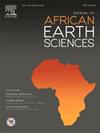Detrital zircon U-Pb geochronology of the Moatize and N'Condédzi coalfields, Zambezi Karoo Basin of Mozambique: Implications for provenance, sediment dispersal and basin evolution
IF 2.2
4区 地球科学
Q2 GEOSCIENCES, MULTIDISCIPLINARY
引用次数: 0
Abstract
Detrital zircon U-Pb geochronology of the Moatize and N'Condédzi coalfields in the Zambezi Karoo Basin of Mozambique provides key insights into the regional provenance, sediment dispersal pathways and basin evolution. Borehole cores from the two coalfields reveal a stratigraphy spanning the early Roadian (middle Permian) to the Carnian (Upper Triassic). The Permian sandstones of the Moatize Coalfield (MC) yield three detrital zircon populations, with ages ranging from 1150 to 950 Ma, 900–780 Ma and 650–490 Ma. In contrast, the Permian sandstones of the N'Condédzi Coalfield (NC) have only one population, which ranges from 1150 to 950 Ma. During the Permian, the provenance area for the NC was the Tete-Chipata Terrane and Malawi Complex (1150–950 Ma) to the north-northeast. In the MC, the detrital zircon populations of the early lake delta depositional setting (Roadian to Wordian) indicate a main provenance in the Zambezi Belt (900–780 Ma) located to the south of the MC, with minor sourcing from the Nampula Block (1150–950 Ma and 650–490 Ma) to the east. The transition from a lake delta to an alluvial depositional setting is attributed to a major tectonic event in the MC, which involved the formation of a braided channel belt. Sandstones from this braided channel belt yield three detrital zircons populations (650–490 Ma, 900–780 Ma and 1150–950 Ma), indicating provenance from both the Zambezi Belt and the Nampula Block. The overlying sandstones in the MC show only a minor population from the Zambezi Belt (900–780 Ma), implying a shift in provenance to the Nampula Block that was likely induced by tectonics. The absence of detrital zircon populations of 900–780 Ma and 650–490 in the Permian sandstones of NC implies that the two coalfields were not connected during the mid to late Permian. It is likely that an intra-rift horst (the Mesoproterozoic Gabbro-Anorthosite Tete Suite) separated the two coalfields. The Lower Triassic sandstones of the NC yield a main detrital zircon population indicating provenance from the Tete-Chipata Terrane and Malawi Complex (1150–950 Ma). A minor population at 650–490 Ma is linked to increased aridity at the Permian – Triassic boundary, which caused expansion of the watershed across the Tete-Chipata Terrane and the Malawi Complex. The Upper Triassic sandstones in the NC yield a 1150–950 Ma detrital zircon population, indicating provenance from the Tete-Chipata Terrane and Malawi Complex and a return to the source-to-sink conditions seen in the mid to late Permian.
莫桑比克赞比西河卡鲁盆地 Moatize 和 N'Condédzi 煤田的碎屑锆石 U-Pb 地球年代学:对出处、沉积物扩散和盆地演化的影响
莫桑比克赞比西河卡鲁盆地 Moatize 和 N'Condédzi 煤田的碎屑锆石 U-Pb 地质年代学提供了有关区域来源、沉积物扩散途径和盆地演化的重要信息。这两个煤田的钻孔岩心揭示的地层跨越了早期路德安(中二叠统)至卡尼安(上三叠统)。Moatize煤田(MC)的二叠纪砂岩产生了三个锆英石碎片群,年龄分别为1150-950Ma、900-780Ma和650-490Ma。相比之下,N'Condédzi 煤田(NC)的二叠纪砂岩只有一个族群,年龄在 1150 至 950 Ma 之间。在二叠纪期间,NC 的产地是东北偏北的 Tete-Chipata Terrane 和马拉维复合体(1150-950 Ma)。在MC地区,早期湖泊三角洲沉积环境(Roadian至Wordian)的锆英石碎片群表明,其主要产地位于MC南部的赞比西河带(900-780 Ma),东部的楠普拉区块(1150-950 Ma和650-490 Ma)是其次要产地。从湖泊三角洲到冲积沉积环境的转变归因于管委会的一次重大构造事件,其中涉及辫状河道带的形成。来自该辫状河道带的砂岩产生了三个碎片锆石群(650-490 Ma、900-780 Ma 和 1150-950 Ma),表明其来源于赞比西河带和楠普拉区块。MC上覆砂岩仅有少量来自赞比西河带(900-780 Ma)的锆石,这意味着其产地可能因构造作用而转移到了楠普拉地块。在 NC 的二叠纪砂岩中没有 900-780 Ma 和 650-490 Ma 的碎屑锆石群,这意味着这两个煤田在二叠纪中晚期并不相连。很可能是一个裂谷内的地角(中新生代加布罗-正长岩泰特组)将两个煤田分隔开来。北卡罗来纳州的下三叠统砂岩产生了一个主要的锆英石碎片群,表明其来源于泰特-奇帕塔地层和马拉维复合体(1150-950 Ma)。650-490Ma的少量锆石与二叠纪-三叠纪交界处干旱加剧有关,干旱加剧导致了Tete-Chipata Terrane和马拉维复合体流域的扩展。北卡罗来纳州的上三叠世砂岩产生了 1150-950 Ma 的锆石碎片群,表明其来源于 Tete-Chipata Terrane 和马拉维复合体,并恢复了二叠纪中晚期的源-汇条件。
本文章由计算机程序翻译,如有差异,请以英文原文为准。
求助全文
约1分钟内获得全文
求助全文
来源期刊

Journal of African Earth Sciences
地学-地球科学综合
CiteScore
4.70
自引率
4.30%
发文量
240
审稿时长
12 months
期刊介绍:
The Journal of African Earth Sciences sees itself as the prime geological journal for all aspects of the Earth Sciences about the African plate. Papers dealing with peripheral areas are welcome if they demonstrate a tight link with Africa.
The Journal publishes high quality, peer-reviewed scientific papers. It is devoted primarily to research papers but short communications relating to new developments of broad interest, reviews and book reviews will also be considered. Papers must have international appeal and should present work of more regional than local significance and dealing with well identified and justified scientific questions. Specialised technical papers, analytical or exploration reports must be avoided. Papers on applied geology should preferably be linked to such core disciplines and must be addressed to a more general geoscientific audience.
 求助内容:
求助内容: 应助结果提醒方式:
应助结果提醒方式:


